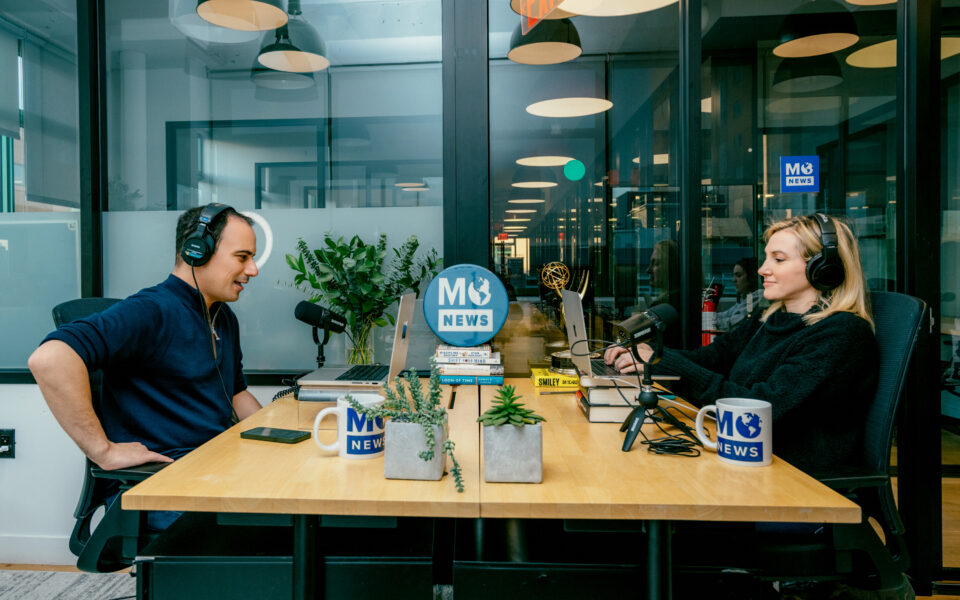Instagram’s uneasy rise as a news site

On a recent Wednesday in New York City, Mosheh Oinounou, a former producer for CBS, Bloomberg News and Fox News, swiped through Instagram. He had started his morning reading major newspapers and more than a dozen newsletters. Then he spent much of the day turning many of the articles into posts on his Instagram account, under the handle Mo News.
A Wall Street Journal story on aging Americans was relayed through a picture of a cake declaring, “Record Number of Americans Will Turn 65 This Year: Wealthy, Active, And Single.” At times, Oinounou, an affable 41-year-old, has also appeared on camera with the co-host of his daily news podcast to explain the significance of how Republican presidential candidates were polling and why President Joe Biden was a write-in candidate in New Hampshire.
The content has earned Mo News 436,000 Instagram followers, turning what had been a pandemic side project into an enterprise with three full-time employees and a bigger spotlight. In December, the State Department offered Mo News an interview with Secretary of State Antony Blinken. Oinounou said the agency had told him, “We understand how people are getting their news.”
“People are very critical and cynical about information they’re getting from traditional outlets,” Oinounou said in an interview. “It resonates where this guy on Instagram is breaking down the news.”
Oinounou is part of a crop of personalities who have figured out how to package information and deliver it on Instagram, increasingly turning the social platform into a force in news. Many millennials and Gen X-ers, in an echo of how older generations used Facebook, have grown more comfortable reading news on Instagram and reposting posts and videos for friends on Instagram Stories, which disappear after 24 hours.
Traditional news organizations, including The New York Times, have large Instagram feeds where they share reporting, but these news accounts hold a different appeal and have become more visible in recent years.
They curate content such as old-school blogs and talk to the camera like TikTok and YouTube influencers. They source headlines from many major outlets while adding their own analysis. They talk with followers in comments and via direct messages, using the feedback and questions to shape additional posts. Many promise to be nonpartisan.
“For many people, they have the chefs that they trust, the doctors they trust and then there’s a category of news and information they trust,” said Jessica Yellin, a former chief White House correspondent for CNN. Yellin, who has more than 650,000 followers on her news Instagram account and a media brand called News Not Noise, calls herself an “info-encer.”
All of this makes Instagram, which is owned by Meta, an increasingly important news outlet in this year’s US presidential election. As of last year, 16% of US adults regularly got news on Instagram, outpacing TikTok, X and Reddit, and up from 8% in 2018, according to Pew Research. More than half of that group were women.
News influencers have become popular on Instagram even as the platform has tried deemphasizing political content. Instagram and its sister platform, Facebook, have been plagued by accusations of spreading misinformation and inflaming political debates. Adam Mosseri, the head of Instagram, has been averse to the app’s teaming up with or promoting news accounts.
This month, Mosseri said Instagram would not recommend “political content” across different parts of the app unless users opted in to seeing it. The platform said political content included posts that were “potentially related to things like laws, elections or social topics.”
In the week after Mosseri’s announcement, news accounts experienced a decline in shares, comments, likes, reach and video views, according to an analysis by Dash Hudson, a social media management firm. Shares of posts from 70 major news accounts on Instagram, including the Times and NPR, fell 26% week over week on average, the firm found.
In protest, Yellin made a video denouncing Instagram’s changes and wrote in her newsletter that the moves would “inevitably impact how well the electorate is informed, and could have far-reaching repercussions for the future of media and even democracy.”
An Instagram spokesperson declined to comment beyond Mosseri’s statements. Mosseri has previously praised some news influencers for their work. He follows a paid subscriber-only account of Mo News on Instagram.
Other prominent news influencers on Instagram include Sharon McMahon, 46, a former high school teacher in Duluth, Minnesota, who has attracted more than 1 million followers by explaining the fundamentals of government. There are more overtly political influencers, such as Emily Amick, 39, a lawyer with more than 134,000 followers. Other news accounts include Roca News, founded by 20-somethings who view Instagram as a key way to reach peers who feel alienated by traditional news outlets.
McMahon said she had been inspired to start her Instagram news account after seeing misinformation in the run-up to the 2020 election. She recently posted charts on migrant encounters at the southern US border sourced from Customs and Border Protection on her Instagram account, garnering more than 30,000 likes, as well as an interview with Rep. Dean Phillips, a Democrat from Minnesota who is a long-shot challenger to Biden.
“I don’t really view myself as a journalist, but more as a teacher,” McMahon said. “I’m explaining what’s happening rather than getting a scoop, digging up the story and making sources.”
Instagram is a starting point for extending into newsletters and podcasts, where the accounts can make money from ads or subscriptions. Many news influencers also accept paid sponsorship deals that they incorporate into Instagram posts. McMahon runs a private book club for subscribers – which has a waitlist to join – and offers paid video workshops to learn more about government and current political issues.
Yellin, the former CNN correspondent, began posting news on Instagram in 2018 around the time of the Supreme Court confirmation hearings of Brett Kavanaugh. She walked people through what had happened in the hearings and posted explainers during the Trump administration, such as defining terms like sanctions for her followers.
Yellin’s rise was helped by celebrity fans such as Jessica Seinfeld and Amy Schumer. Seinfeld, who has about 600,000 Instagram followers, came across Yellin’s news account and urged people to follow it.
“My idea was we can engage news avoiders and we can also engage people who are partially attentive to the news but panicked by it,” said Yellin, who has five full- and part-time employees.
Her ethos for delivering news on Instagram is summed up by her tagline: “We give you information, not a panic attack.”
When the White House threw an inaugural holiday party for internet influencers last year, Oinounou, Yellin and Amick were invited. Christian Tom, director of the White House’s office of digital strategy, who helped come up with the idea for the party, said the administration regularly worked with Instagram news accounts.
“There are so many accounts that share news and information that have an audience of millions of people who might not hear from the White House or may not follow the White House at all,” he said.
Tom pointed to Instagram-first news brands such as @Impact and @Betches_News, meme and entertainment accounts such as @Pubity, and progressive media publications such as MeidasTouch and A More Perfect Union.
“Each generation crafts these tools and uses them in their own way,” he said.
Even with Instagram’s changes to news content, users are set to continue seeing news from the accounts they already follow and via their friends’ Stories.
“Everyone has sort of become a broadcaster or a source of information for their friends and family,” Oinounou said.
Amick said she had watched her peers gravitate to Instagram for news as “social media apps have become stratified by generation.” She considers herself something of an “at-large opinion editor,” rather than a news source such as Mo News or Yellin, and views Instagram as a place to mobilize millennial women around issues such as reproductive rights.
“My friends who are millennial moms are busy – they have jobs, they have kids, they have to put food on the table,” she said. “They don’t have tons of extra time to consume news, and they were already on Instagram. So this is the way for them to be able to consume news through a modality they’re already using.”
This article originally appeared in The New York Times.






